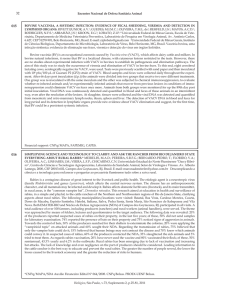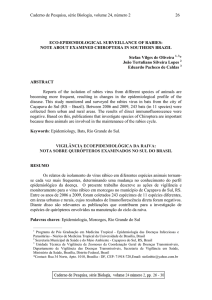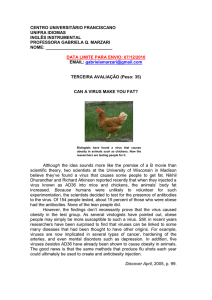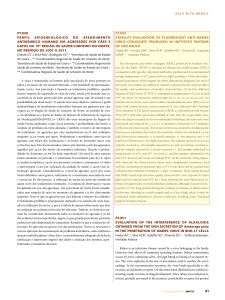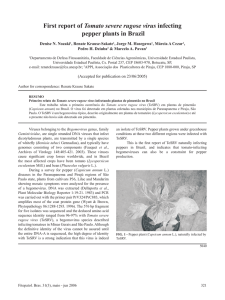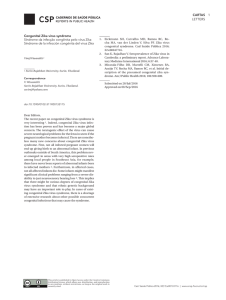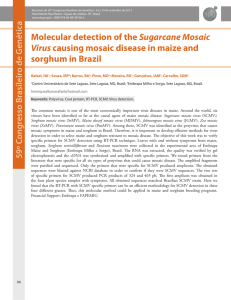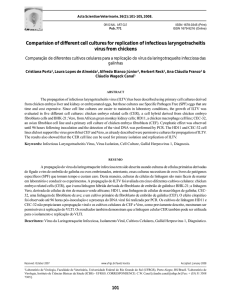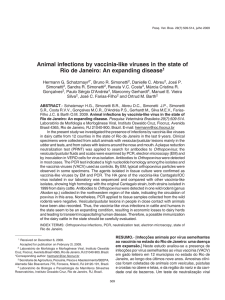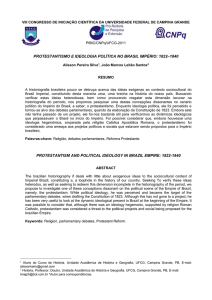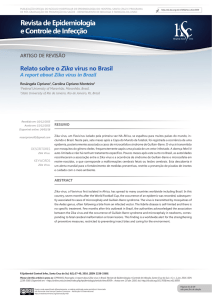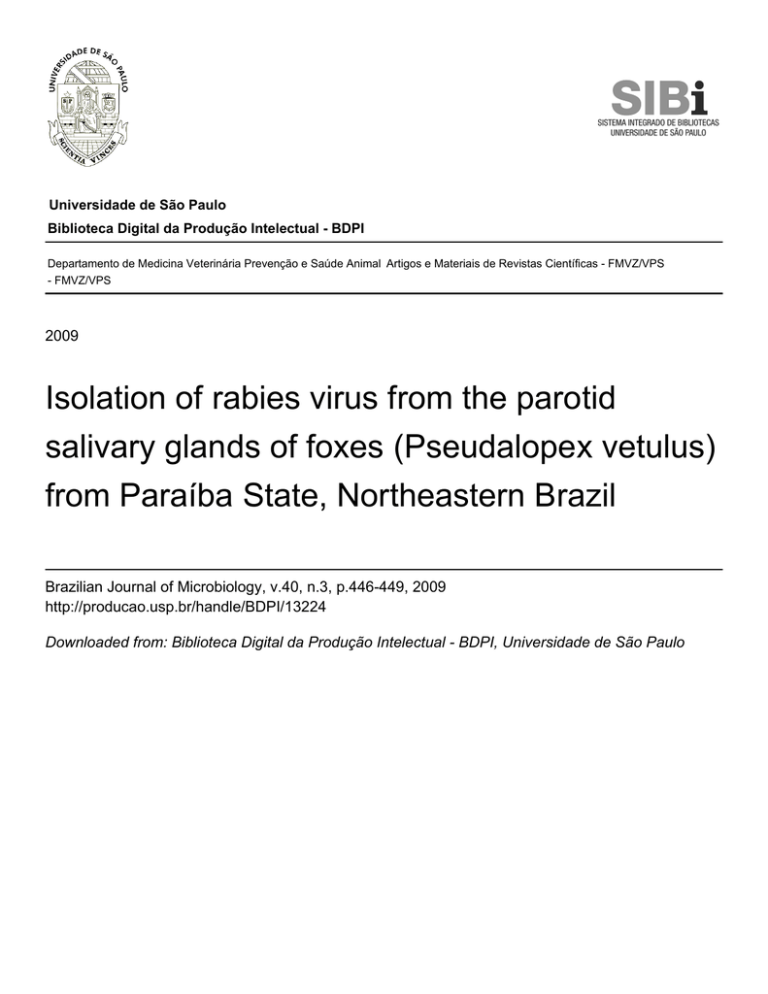
Universidade de São Paulo
Biblioteca Digital da Produção Intelectual - BDPI
Departamento de Medicina Veterinária Prevenção e Saúde Animal Artigos e Materiais de Revistas Científicas - FMVZ/VPS
- FMVZ/VPS
2009
Isolation of rabies virus from the parotid
salivary glands of foxes (Pseudalopex vetulus)
from Paraíba State, Northeastern Brazil
Brazilian Journal of Microbiology, v.40, n.3, p.446-449, 2009
http://producao.usp.br/handle/BDPI/13224
Downloaded from: Biblioteca Digital da Produção Intelectual - BDPI, Universidade de São Paulo
Brazilian Journal of Microbiology (2009) 40: 446-449
ISSN 1517-8382
ISOLATION OF RABIES VIRUS FROM THE PAROTID SALIVARY GLANDS OF FOXES (Pseudalopex vetulus)
FROM PARAÍBA STATE, NORTHEASTERN BRAZIL
Maria Luana Cristiny Rodrigues Silva1, Fabiano da Silva Lima1, Albério Antônio de Barros Gomes1*, Sérgio Santos de
Azevedo1, Clebert José Alves1, Fernanda Bernardi2, Fumio Honma Ito3
1
Unidade Acadêmica de Medicina Veterinária, Centro de Saúde e Tecnologia Rural, Universidade Federal de Campina
Grande, Patos, PB, Brasil; 2Centro de Vigilância Sanitária e Controle de Zoonoses ‘‘Tereza Rodrigues de Camargo’’, Ibiúna,
SP, Brasil; 3Departamento de Medicina Veterinária Preventiva e Saúde Animal, Faculdade de Medicina Veterinária e
Zootecnia, Universidade de São Paulo, São Paulo, SP, Brasil
Submitted: July 21, 2008; Returned to authors for corrections: August 22, 2008; Approved: May 03, 2009.
ABSTRACT
To determine the presence of rabies virus in the parotid salivary glands, 12 road-killed rabies-positive
hoary foxes (Pseudoalopex vetulus) were tested by using the fluorescent antibody test (FAT) and mouse
inoculation test (MIT). All 12 parotid salivary glands were positive for both tests, although in some
cases several passages were required. The findings of this study support the importance of the hoary fox
as rabies reservoir in the semi-arid region of Paraíba State, Northeastern Brazil.
Key-words: Parotid gland, fox, rabies virus, isolation, Paraíba State
Rabies is primarily transmitted by the inoculation of the
compared (17).
virus within the saliva through the bite of an infected animal.
The hoary fox (Pseudalopex vetulus) is widely
The most important reservoirs for human rabies in Latin
distributed in Brazil, especially in the northeastern region
America is the dog and wild animals as foxes, and bats are
where it is common to raise foxes and other wild animals as
also responsible for transmission to human and animals (1).
pets, although this practice is considered a felony by the
In northern Colombia, rabies viruses were isolated from foxes
IBAMA (Brazilian Institute for Environment and Natural
(Urocyon cinereoargenteus), dogs and humans and all
Resources). This close relationship between man and wild
belonged to a single genetic variant, when G-L intergenic
animals raises the risk of rabies transmission to human and
region and protein G and a fragment of L protein were
domestic animals (13).
*Corresponding Author. Mailing address: Universidade Federal de Campina Grande, Av. Universitária, Bairro Santa Cecília, 58700-970, Caixa Postal 64,
Patos, Paraíba, Brasil.; Tel. +55 83 3423 3397; fax: +55 83 3423 4659.; E-mail: [email protected]
446
Rabies virus in foxes
There are reported cases of rabid foxes and human
intracerebrally in groups of ten mice, according to
transmission in the states of Ceará (3), Paraíba (13),
Koprowski (15). Mice were daily observed for 21 days for
Pernambuco, Bahia and Minas Gerais (2). During the period
rabies symptoms. After this period, brain from mice groups
of August 15th 2000 to February 11th 2003, 24 humans
which did not show rabies signs were collected and re
were attacked by hoary foxes in the semi-arid region of
inoculated using the same procedure. Mice that died prior to
Paraíba and medicated in Patos Municipality (19).
the end of the 21 days were confirmed by FAT applied to
The
antigenic
characterization
with
monoclonal
their brain tissues.
antibodies and the partial genetic sequencing of the P gene
Mice used for diagnostic and virus isolation procedures
of rabies virus samples isolated from Brazilian domestic and
were 21 day-old Swiss albino, lineage CH3 Rockfeller,
wild canids showed two rabies groups related to the hoary
weighing from 11 to 15 grams, and maintained at the
fox (P. vetulus), which straighten the importance of this
UAMV/CSTR/UFCG facilities.
The fluorescent antibody test was made according
species as a rabies virus reservoir in the semi-arid region of
the state of Paraíba (7).
The aim of this work was to isolate rabies virus from
to Goldwasser and Kissling (12) and modified by Dean et
al. (10).
the parotid salivary glands of the hoary foxes (P. vetulus) of
All 12 parotid salivary glands were positive for both
the semi-arid region of Paraíba State, Northeastern Brazil,
FAT and MIT, although two of them required two mouse
which had been diagnosed positive for rabies by means of
passages and the other needed three additional passages, as
the fluorescent antibody (FAT) and mouse inoculation test
shown in Table 1.
(MIT) of brain materials.
Matouch et al. (16) inoculated fourteen foxes
Materials of the salivary glands taken from the hoary
intramuscularly with 50 or 5,000 LD50 of rabies virus in red
foxes of the semi-arid region of the state of Paraíba were
foxes (Vulpes vulpes), and demonstrated the presence of
provided by the Virology Laboratory of the Veterinary
rabies virus in the saliva of 12 animals and in the salivary
Medicine Academic Unit, Health Center and Rural
glands of 13 ones. Carey and Lean (6) reported that the viral
Technology, Federal University of Campina Grande
titer found in salivary gland (10-4.2) was similar to that
(UAMV/CSTR/UFCG), and IBAMA’s license number
obtained for brain (10-4.5), but titers in other animals were
3322001-CGEF to make research on the Brazilian wild
varied, 10-3.0 and 10-4.6, respectively for salivary gland and
canids. A total of 12 road-killed out of 287 examined had
brain. Secord et al. (18) showed that virus was in parotid
been diagnosed positive for rabies through the FAT and
salivary gland of 43 (97.7%) of 44 foxes. Beauregard and
MIT applied for brain specimens.
Casey (4) detected rabies antigen in salivary glands of 23
Twelve parotid salivary glands from these animals were
selected and individually macerated and diluted to make a
20% suspension with a solution of sterilized distilled water
foxes through FAT and MIT and our results corroborate the
results of the previous works.
Rabies virus was detected in salivary glands of skunks
containing 2% (v/v) rabbit sera, penicillin (500 IU/mL) and
(Mephitis
streptomycin (1,560 IU/mL). After centrifuging at 2,000
submandibular and lower for zygomatic, molar, and
rpm for 10 minutes, a volume of 0.03 mL was inoculated
sublingual glands, while for nasal mucosa the viral titers
mephitis)
and
titers
were
higher
for
447
Silva, M.L.C.R. et al.
varied from low to moderate, and occasionally they were
Carnieli Jr et al. (7) in the analyzes of the molecular
similar to those found for brain samples (4).
epidemiology of rabies virus isolated from wild canids in
Delpietro et al. (11) isolated rabies virus from 4.6% of
Northeastern Brazil, indicated two distinct rabies cycles
salivary glands (submaxillary and parotid) and 1% of saliva
among canids in Brazil, one represented by wild canids and
of 87 naturally infected bovines.
the other domestic canids. Carnieli Jr et al. (8) reported that
From the rabid hoary foxes, it is possible to isolate
foxes (Cerdocyon thous and Pseudalopex vetulus) are
rabies virus from the parotid salivary glands, although in
frequently associated with rabies. Kobayashi et al. (14)
some situation it might be necessary to perform more than
performed the phylogenetic chararacterization of rabies
one brain passage in mouse. These results may be explained
virus from carnivores in Brazil, and they found in the state
by the freezing condition submitted to preserve the
of Paraíba, two sublineages of fox rabies viruses.
biological specimens, which culminated with a very low
These findings support the importance of the hoary fox
viral titer, necessitating the blind passages in mice for viral
as rabies reservoir in the semi-arid region of Paraíba State,
isolation.
Northeastern Brazil.
Table 1. Results of the fluorescent antibody test (FAT) and mouse inoculation test (MIT) in brain tissue of mice inoculated
with suspensions of parotid salivary glands of the road-killed hoary foxes positive for rabies, Paraíba State, Brazil
Hoary Fox
Samples
1
2
3
4
5
6
7
8
9
10
11
12
FAT
+
+
+
+
+
+
+
+
+
+
+
+
1st Passage
+
+
+
+
+
+
+
+
+
MIT
2nd Passage
------+
------+
-------
3rd Passage
----+
-------------------
+ = Positive
- = Negative
RESUMO
Para determinar a presença de vírus rábico em glândulas
salivares parótidas, 12 raposas (Pseudalopex vetulus)
Isolamento de vírus rábico de glândulas salivares
atropeladas em rodovias e positivas para raiva foram
parótidas de raposas (Pseudalopex vetulus) do Estado da
testadas pelo teste de imunofluorescência direta (IFD) e
Paraíba, Nordeste do Brasil.
teste de inoculação em camundongos (IC). Todas as 12
448
Rabies virus in foxes
glândulas salivares parótidas foram positivas em ambos os
Machado, L.M.; Carrieri, M.L.; Kotait, I. (2008). Characterization of
testes, embora, em alguns casos, várias passagens terem sido
rabies vírus isolated from canids and identification of the main wild
necessárias. Os achados do presente trabalho reforçam a
importância das raposas como reservatórios de raiva no
semi-árido do Estado da Paraíba, Nordeste do Brasil.
canid host in Northeastern Brazil. Virus Res., 131, 33-46.
9.
Charlton, K.M.; Casey, G.; Webster, W.A. (1984). Rabies virus in
the salivary glands and nasal mucosa of naturally infected skunks.
Can. J. Comp. Med., 48, 338-339.
10. Dean, D.J.; Abelseth, M.K.; Atanasiu, P. (1996). The fluorescent
Palavras-chave: Glândula parótida, raposa, vírus rábico,
isolamento, Estado da Paraíba
antibody test. In: Meslin, F.X., Kaplan, M.M., Koprowski, H. (eds.).
Laboratory techniques in rabies. 4th ed. World Health Organization,
Geneva, p.88-95.
11. Delpietro, H.A.; Larghi, O.P.; Russo, R.G. (2001). Virus isolation
REFERENCES
from saliva and salivary glands of cattle naturally infected with
paralytic rabies. Prev. Vet. Med., 48, 223-228.
12. Goldwasser, R.A.; Kissling, R.E. (1958). Fluorescent antibody
1.
Acha,
P.N.; Szyfres, B.
(1986).
Zoonosis y enfermedades
transmisibles comunes al hombre y a los animales. 2nd ed.
Organización Panamericana de la Salud, Washington, 989p.
2.
Araújo, F.A.A. (2002). Raiva humana no Brasil: 1992-2001. Belo
Horizonte, Brasil, 90p. (M.Sc. Dissertation, Escola de Veterinária,
Universidade Federal de Minas Gerais).
3.
Barros, J.S.; Freitas, C.E.A.A.; Sousa, F.S. (1989). Raiva em animais
silvestres no Estado do Ceará particularmente na raposa (Dusicyon
vetulus). Zoon. Rev. Int., 1, 9-13.
4.
Beauregard, M.; Casey, G.A. (1965). Demonstration of rabies antigen
in salivary glands of rabies suspected animals. Can. J. Comp. Med.,
33, 55-58.
5.
Bernardi, F.; Nadin-Davis, S.A.; Wandeler, A.I.; Armstrong, J.;
Gomes A.A.B.; Lima, F.S.; Nogueira, F.R.B.; Ito, F.H. (2005).
Antigenic and genetic characterization of rabies viruses isolated from
domestic and wild animals of Brazil identifies the hoary fox as a
rabies reservoir. J. Gen. Virol., 86, 3153-3162.
6.
Carey, A.B.; Lean, R.G.M.C. (1978). Rabies antibody prevalence and
virus tissue tropism in wild carnivores in Virginia. J. Wildl. Dis., 14,
487-491.
7.
Carnieli Jr., P.; Brandão, P.E.; Carrieri, M.L.; Castilho, J.G.; Macedo,
C.I.; Machado, L.M.; Rangel, N.; Carvalho, R.C.; Carvalho, V.A.;
Montebello L.; Wada, M.; Kotait, I. (2006). Molecular epidemiology
of rabies virus strains isolated from wild canids in Northeastern
Brazil. Virus Res., 120, 113-120.
8.
Carnieli Jr., P.; Fahl, W.O.; Castilho, J.G.; Oliveira, R.N.; Macedo,
staining of street and fixed rabies virus antigens. Proc. Soc. Exptl.
Biol. Med., 98, 219-223.
13. Gomes, A.A.B. (2004). Epidemiologia da raiva: caracterização de
vírus isolados de animais domésticos e silvestres do semi-árido
paraibano da região de Patos, Nordeste do Brasil. São Paulo, Brasil,
107p. (Thesis, Faculdade de Medicina Veterinária e Zootecnia,
Universidade de São Paulo).
14. Kobayashi, Y.; Inoue, N.; Sato, G.; Itou, T.; Santos, H. P.; Brito, C. J.
C.; Gomes, A. A. B.; Santos, M. F. C.; Silva, M. V.; Mota, C. M.; Ito,
F. H.; Sakai T. (2007). Phylogenetic characterization of rabies virus
isolated from carnivora in Brazil. J. Vet. Med. Sci. 69, 691-696.
15. Koprowski, H. (1996). The mouse inoculation test. In: Meslin, F.X.,
Kaplan, M.M., Koprowski, H. (eds.) Laboratory techniques in rabies.
4th ed. World Health Organization, Geneva, p.80-87.
16. Matouch, O.; Jaros, J.; Pohl P. (1984). Excretion of the rabies virus in
foxes after experimental infection. Vet. Med. (Praha), 29, 653-658.
17. Páez, A.; Saac, C.; Núñez, C.; Bóshell, J. (2005). Molecular
epidemiology of rabies in northern Colombia 1994-2003. Evidence
for human and fox rabies associated with dogs. Epidemiology and
Infection. 133, 529-536.
18. Secord, D.C.; Bradley, J.A.; Eaton, R.D.; Mitchell, D. (1980).
Prevalence of rabies virus in foxes trapped in the Canadian Artic.
Can. Vet. J., 21, 297-300.
19. Sousa, M.H. (2003). Livro de registro permanente de controle da
vacina anti-rábica humana. Unidade Básica de Saúde Aderban
Martins, Patos, PB, Brasil, p.1-18.
C.I.; Durymanova, E.; Jorge, R.S.P., Morato, R.G.; Spíndola, R.O.;
449

